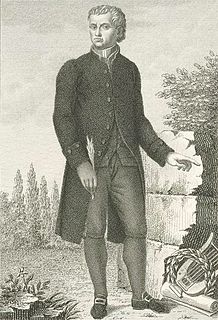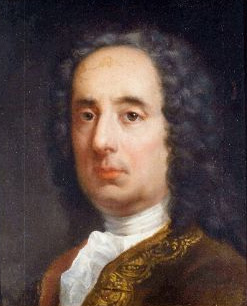Notes
| | This article about an Italian composer is a stub. You can help Wikipedia by expanding it. |
Antonio Maria Pacchioni (baptised 5 July 1654 - 15 July 1738) of Modena was a Baroque composer, known for his polyphonic church music. He studied violin technique with Giovanni Maria Bononcini and musical composition with Padre A. Bendinelli. [1] He received holy orders in 1677, which enabled him to become maestro di cappella of the Duomo of Modena in 1694. His oratorios were among the first to be heard publicly in Modena (1677, 1678); of surviving compositions, two were on sacred subjects while a third (1682) concerned the quasi-legendary countess Matilda of Tuscany. His four-voice a cappella motets In monte Oliveti and Velum templi have been recorded.
Pacchioni also served as vice-maestro and then maestro di cappella at the ducal court of Rinaldo d'Este (1655–1737).
Among his pupils was the violinist-composer Tomaso Antonio Vitali.
| | This article about an Italian composer is a stub. You can help Wikipedia by expanding it. |

Giuseppe Ottavio Pitoni was an Italian organist and composer. He became one of the leading musicians in Rome during the late Baroque era, the first half of the 18th century.

Carlo Innocenzo Frugoni was an Italian poet and librettist. As a poet Frugoni was one of the best of the school of the Arcadian Academy, and his lyrics and pastorals had great facility and elegance. His collected works were published at Parma in 10 volumes in 1799, and a more complete edition appeared at Lucca in the same year in 15 volumes.

Giacomo Antonio Perti was an Italian composer of the Baroque era. He was mainly active at Bologna, where he was Maestro di Cappella for sixty years. He was the teacher of Giuseppe Torelli and Giovanni Battista Martini.

Giovanni Bononcini was an Italian Baroque composer, cellist, singer and teacher, one of a family of string players and composers.

Giovanni Maria Nanino was an Italian composer and teacher of the late Renaissance. He was a member of the Roman School of composers, and was the most influential music teacher in Rome in the late 16th century. He was the older brother of composer Giovanni Bernardino Nanino.
Giovanni Carlo Maria Clari was an Italian musical composer and maestro di cappella (chapel-master) at Pistoia. He was born at Pisa. He gained his initial grounding in musical education from his father, a violinist originally from Rome who was employed in the service of the church of the Cavalieri di S. Stefano in Pisa.

Antonio Maria Bononcini was an Italian cellist and composer, the younger brother of the better-known Giovanni Bononcini.
Marco Uccellini was an Italian Baroque violinist and composer. His output of mainly secular music for solo violin is considered to have been important in the rise of independent instrumental classical music, and in the development of violin technique.

The Accademia Filarmonica di Bologna is a music education institution in Bologna, Italy.
Ludovico Balbi was a Venetian singer and composer, and conductor. He was a pupil of Costanzo Porta and a choirmaster at Padua. Among his compositions are masses, motets, canzoni, madrigals, and others. Surviving compositions date as early as 1570.
Antonio Maria Abbatini was an Italian composer, active mainly in Rome.
The decade of the 1540s in music involved some significant events.
Giovanni Battista Vitali was an Italian composer and violone player.
Giovanni Battista Bassani was an Italian composer, violinist, and organist.
Giacomo Fogliano was an Italian composer, organist, harpsichordist, and music teacher of the Renaissance, active mainly in Modena in northern Italy. He was a composer of frottole, the popular vocal form ancestral to the madrigal, and later in his career he also wrote madrigals themselves. He also wrote some sacred music and a few instrumental compositions.
Alessandro Melani was an Italian composer and the brother of composer Jacopo Melani, and castrato singer Atto Melani. Along with Bernardo Pasquini and Alessandro Scarlatti, he was one of the leading composers active in Rome during the 17th century. He is also ranked among the second school of Roman opera composers which began with his brother's 1668 opera Il Girello. He is chiefly remembered today for his large output of liturgical music that he wrote while serving in various musical posts in Rome. Of particular interest is the large number of polychoral motets that he produced and his eight ascribed oratorios. Three published collections of his liturgical music survive today along with numerous solitary motets from other published volumes. A number of original manuscripts also survive.
Andrea Adolfati was an Italian composer who is particularly remembered for his output of opera serias. His works are generally conventional and stylistically similar to the operas of his teacher Baldassare Galuppi. Although his music largely followed the fashion of his time, he did compose two tunes with unusual time signatures for his day: an air in 5
4 meter and another in 7
4 meter.
Giovanni Domenico Freschi was an Italian composer and Roman Catholic priest. From the age of 22 until his death he worked as a church musician and composer in Vincenza. He was also active as an opera composer from 1671 to 1685.

Fedele Fenaroli was an Italian composer and teacher. Fenaroli entered the Conservatorio di Santa Maria di Loreto, one of the Music conservatories of Naples, becoming a pupil of Francesco Durante. In 1762 he was appointed Maestro di Cappella. Among his students were many celebrated Italian composers, such as Domenico Cimarosa, Nicola Antonio Zingarelli, and Saverio Mercadante. Giuseppe Verdi was a second-generation student, as his teacher, Vincenzo Lavigna, was a student of Fenaroli. Fenaroli wrote several treatises on music, which were widely used during the nineteenth century. As a composer, he wrote mainly sacred music. See: List of music students by teacher: C to F#Fedele Fenaroli.
Antonio Gianettini was an Italian organist, concertmaster and composer.